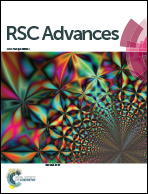Optical response of a quantum dot–epoxy resin composite: effect of tensile strain
Abstract
The structural applications of quantum dots (QDs) can be artificially realized through the preparation of QDs-based structural materials, which have unique characteristics of photoluminescence (PL) in response to mechanical deformation, via the dispersion of quantum dots in various materials, including polymers and plastics. A QDs-based composite consisting of CdSe@ZnS core–shell QDs and a bisphenol-A type epoxy resin has been prepared by mixing a solution of CdSe@ZnS core–shell QDs in chloroform with bisphenol-A type epoxy resin and modified amine at room temperature. The tensile deformation of the tensile specimens made from the QDs-based composite causes a significant change in the PL intensity for large engineering strains, and there is no observable strain-induced shift of the wavelength corresponding to the maximum PL intensity. Two major modes are observed for the temporal variation of the PL intensity of the QDs-based composite coated on AA 7009 tensile specimens under cyclic loading and unloading of small strains. One exhibits in-phase characteristics with strain, and the other exhibits antiphase characteristics with strain. The variation of the PL intensity of the QDs-based composite with tensile strain suggests that there exists strain-dependent photoluminescence, which determines the PL characteristics of the CdSe@ZnS core–shell QDs in the bisphenol-A type epoxy under the irradiation of ultraviolet light. The experimental results demonstrate the potential of developing sensitive opto-mechanical devices from QDs-based composites.


 Please wait while we load your content...
Please wait while we load your content...